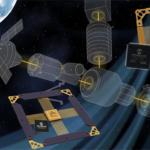It’s now cheaper than ever to launch small and nano-satellites into space thanks to NASA’s CubeSat Launch initiative (CSLI) – and this is excellent news for developers of remote Internet of Things (IoT) applications.
For the uninitiated, CubeSats are research spacecraft that measure around 4 inches (102mm) long and are taken into space on rocket payloads. The beauty of them is that they make it possible to reduce the cost of direct satellite communication. They also simplify the process by managing modulation through binary phase shift keying (BPSK). While there are undoubtedly restrictions on the volume of data that can be handled through this approach, it sits well with remote IoT applications since many of them deal with low-scale status notifications that are often repeated and can consist of nothing more than a variety of numbers. Reliability of data delivery is also ensured through the built-in robustness of BPSK modulation.
Look, no wires…
Communicating via wireless networks is now commonplace and is already recognised as the driving force behind expansion of the IoT. Predictions vary but the general understanding is that by 2020 there will be close to 20 billion connected IoT devices in the world. Whether smart cities, intelligent buildings, smart factories, logistics monitoring, disaster prevention or a host of other applications, there are clear advantages to using wireless communications technology.
Many of us are familiar with Bluetooth, Wi-Fi, Zigbee and other wireless systems that are useful forms of connectivity across short distances but the expansion of mobile IoT has to rely on long-range wireless technology that uses low-power wide area networks (LPWANs). The various options available to users have their pros and cons, of course, such as the current capabilities of cellular 5G compared to the promises being made of it. Likewise, Narrowband Internet of Things (NB-IoT) and LTE-M – Long-Term Evolution (4G) category M1 – have their strengths in various applications, with speed and latency being key differentiators. LTE-M, for example, is the best option for mission-critical applications while NB-IoT offers low power consumption, low cost and optimal network architecture.

Why the IoT needs satellite communications
Clearly, long-range transmission of data using minimum power are key factors in any device that is to work within a remote IoT environment. Difficulties can arise, however, when data cannot be passed through a traditional network that uses low-power wide area protocols. There are many instances where terrestrial connections are simply not possible, such as when tracking shipping containers, operating search and rescue beacons or interfacing with weather stations in remote, inhospitable environments.
In such instances, there is no option but to communicate via satellite but – until now – the cost of doing so has proved to be prohibitive and so the use of satellites has been limited to highly mission-critical situations. Thanks to the cost of access to communicating via space dropping dramatically, via NASA’s CubeSats and other small-scale satellites, IoT application developers have identified an opportunity that has previously not been available to them. Whether carrying out scientific experiments or the types of remote tracking and monitoring activities mentioned earlier, the scope of applications that can benefit from easier access to satellites is growing apace.
Finding the right device
As a consequence of the increase in nano-satellites and their adoption by IoT application developers, there is a growing need for transmitters and sensors that use binary phase shift keying. What the sector needs, though, is equipment that is ready to go rather than having to create new devices. Not only does it require a high level of design skills – such as radio frequency (RF) and DSP programming knowledge – to build new BPSK-based transmitters and sensors but it also lengthens the time-to-market for applications developers, which is something to be avoided.
One solution that has been developed is the purpose-built CMX7146 flexible data transmitter IC from CML Microcircuits which enables IoT application developers to deploy a BPSK-based transmitter without the need for a variety of technical skillsets. With such a device to hand, developers can significantly reduce the time from design to delivery of transmit-only solutions for this demanding market sector.

One of a range of narrowband-focused products from the company, the CMX7146 incorporates many features that make it suitable for remote IoT applications. These include not only the transmit modulator function but also low-power analog to digital converters and four GPIO interfaces.
For satellite IoT applications where remote equipment is monitored and relatively small messages are sent, the CMX7146 – which operates from a single 3.3V supply – is capable of supporting either user-configured or predefined data messages and
generating highly accurate signals ready for transmission and for sending to an RF carrier specified by the user. Providing the option of customizing transmit frequencies and channel bandwidths via an external RF modulator, the IC also simplifies modulation shaping and data rate configuration.
As the population of small satellites and nano-satellites like the CubeSat grows, so does the range of possibilities for developers of remote IoT applications who will be on the lookout for any out-of-the-box solution that can shorten that development time, simplify the whole process and give them the edge over their competitors.
About the author
 David Brooke has nearly 40 years of experience working in the electronics industry. As CML’s Wireless/Wireline Voice and Data Product Manager, specializing in baseband solutions, he works across all CML departments managing the products under his care. When he gets some time to himself, he can often be found cooking at home with a glass of red wine in hand
David Brooke has nearly 40 years of experience working in the electronics industry. As CML’s Wireless/Wireline Voice and Data Product Manager, specializing in baseband solutions, he works across all CML departments managing the products under his care. When he gets some time to himself, he can often be found cooking at home with a glass of red wine in hand





Leave a Reply